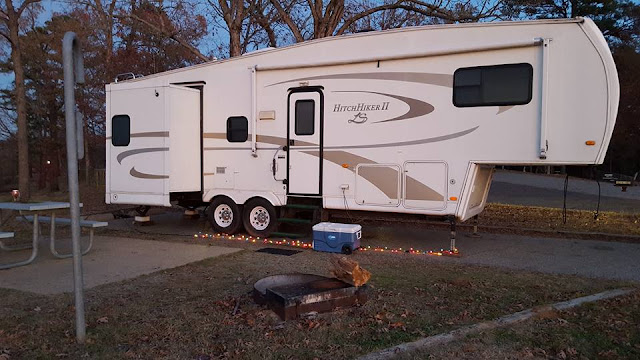Above photo was taken from our campsite..The weather has been pretty cold, but sunny. Dennis is having campfire withdrawal, as they have a burning ban here...We loaded up on firewood in Texarkana and the GMC is definitely over weight..However, some of that weight could be cases of beer..and wine...and rum...and tequila..and brandy..and sweet vermouth..(Hey, I like a good Brandy Manhattan when the weather is cold!)
Our campsite is water and electric..and the views are outstanding..especially the sunsets..
This town of Jefferson is very historic..Yep, get ready for an extended History lesson about Jefferson, TX...Please take notes, there will be a test later...
"Jefferson became a port of entry into the Republic of Texas and then the State of Texas. It was also a major shipping port for those who wished to sell agricultural products, especially cotton. Cotton was brought to Jefferson from as far away as Dallas by ox wagon and then sold in Jefferson through receiving, forwarding, and commission merchants to markets in New Orleans and St. Louis. Many of the immigrants who came to Jefferson stayed and built homes and shops here.
Thomas JeffersonJefferson, Texas is located on Big Cypress Bayou in the Cypress Valley of Northeast Texas. It is the County seat for Marion County. Named for Francis Marion, a Revolutionary War patriot who was known as the “Swamp Fox”, Marion County was created in 1860. Jefferson was named for Thomas Jefferson, and was conceived as a port city by Allen Urquhart and Daniel Alley, who saw its potential as the head of navigation when they prepared a plan for the town site in 1841.
In 1845, when obstructions were removed from Big Cypress Bayou, steamboats could reach Jefferson from New Orleans. After the arrival of the first steamboat, Jefferson became a boom town where many pioneers to Texas first set foot on Texas soil when they disembarked from the steamboats.
During Jefferson’s Golden Era as a steamboat port from 1845 until 1875, it became a cosmopolitan town like most port cities with a confluence of cultures and businesses. The architectural styles, which developed in Jefferson during this period of prosperity, resembled those of New Orleans. The homes were primarily of Greek revival design.
When the log raft was removed by the Army Corps of Engineers in the year 1873, the water level in Big Cypress Bayou was reduced and navigation to Jefferson was threatened. Railroads were also extended during this period of time across Texas, which reduced Jefferson’s commercial market area. The town ceased to be a prominent port city and commercial center. However, many of the mid-nineteenth century homes and buildings on the Historical Registry remain."
Photos to follow...
"Jefferson became a port of entry into the Republic of Texas and then the State of Texas. It was also a major shipping port for those who wished to sell agricultural products, especially cotton. Cotton was brought to Jefferson from as far away as Dallas by ox wagon and then sold in Jefferson through receiving, forwarding, and commission merchants to markets in New Orleans and St. Louis. Many of the immigrants who came to Jefferson stayed and built homes and shops here.
Thomas JeffersonJefferson, Texas is located on Big Cypress Bayou in the Cypress Valley of Northeast Texas. It is the County seat for Marion County. Named for Francis Marion, a Revolutionary War patriot who was known as the “Swamp Fox”, Marion County was created in 1860. Jefferson was named for Thomas Jefferson, and was conceived as a port city by Allen Urquhart and Daniel Alley, who saw its potential as the head of navigation when they prepared a plan for the town site in 1841.
In 1845, when obstructions were removed from Big Cypress Bayou, steamboats could reach Jefferson from New Orleans. After the arrival of the first steamboat, Jefferson became a boom town where many pioneers to Texas first set foot on Texas soil when they disembarked from the steamboats.
During Jefferson’s Golden Era as a steamboat port from 1845 until 1875, it became a cosmopolitan town like most port cities with a confluence of cultures and businesses. The architectural styles, which developed in Jefferson during this period of prosperity, resembled those of New Orleans. The homes were primarily of Greek revival design.
When the log raft was removed by the Army Corps of Engineers in the year 1873, the water level in Big Cypress Bayou was reduced and navigation to Jefferson was threatened. Railroads were also extended during this period of time across Texas, which reduced Jefferson’s commercial market area. The town ceased to be a prominent port city and commercial center. However, many of the mid-nineteenth century homes and buildings on the Historical Registry remain."
Photos to follow...
Jefferson is on the Big Cypress Bayou and they give swamp tours..We took one a couple years ago and it was well worth it..There is also an old historic cemetery here where many notable people are buried..and they give ghost tours of some of the antebellum homes that are haunted..We love it here so much that we booked ourselves right back in the same spot for next March...
Of course, we are familiar with some of the favorite "haunts", and not all are haunted..We love Auntie Skinner's Riverboat Club. I must confess that there is a story of a resident ghost spooking up the stairway after hours...This place is one of the oldest buildings in Jefferson and was many things before it became a bar...and their food is great!
Of course, we are familiar with some of the favorite "haunts", and not all are haunted..We love Auntie Skinner's Riverboat Club. I must confess that there is a story of a resident ghost spooking up the stairway after hours...This place is one of the oldest buildings in Jefferson and was many things before it became a bar...and their food is great!
Soooooo much fun here! It is the original brick and those front windows used to be doors...
Tomorrow, the Cave Dwellers are seeking a new "dwelling place", and so we will dump our tanks and hit the road. Our next destination for Christmas and New Year's Eve will be Crane's Mill Campground in Startzville, TX on Canyon Lake, North of San Antonio. Again, we have stayed here once before. At our age it is best not to have too many surprise destinations..we like structure so we don't forget where we are...Startzville is a 6 1/2 hour drive from here, and this is another thing about aging...We don't ride as well as we did...When we get out of the GMC after that length of time, we need about an hour to get our land legs again....and also we need a huge supply of Ibuprofen..Trust me, parking this thing is much more pleasant when WE are both in a pleasant mood. It is for those reasons that we will just break it up into 2 nights..and arrive Monday after stopping tomorrow night somewhere in between..See, we have learned somethings over the camping years..
We did have a bit of a scare the first morning we arrived..I opened our camper door to this sight....
HOLY BUZZARDS, BATMAN!! It was like they were just waiting for us to get out of bed and take our walk, so they could have an early morning snack..Those darn Vultures seem to show up where ever we go..I cannot imagine why...We have learned to be very careful we don't fall down ...They would be on us like buzzards on carrion..Just the thought makes me tremble..
OK, so that is enough of commanding your attention for the moment...One thing about Texas..the ants make hills the size of the great pyramids, and the mosquitoes are whiskey drinking, gun totin' varmits that can survive a killing frost and are the size of dragon flies...YAHOO!!


































Beautiful sunsets and a great history lesson!! Glad you all are having fun!!
ReplyDelete